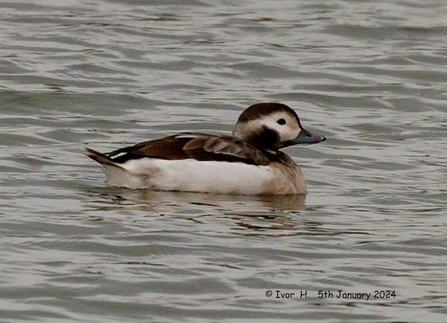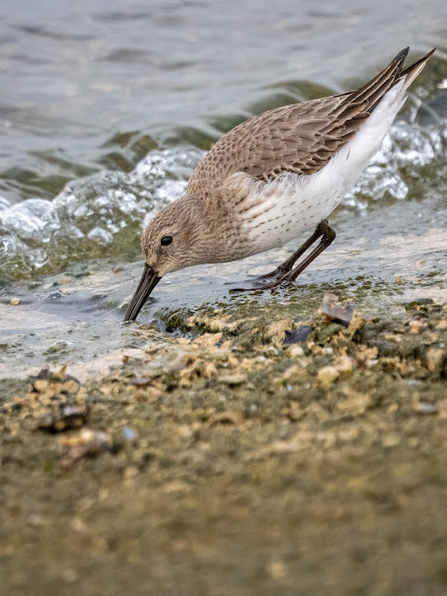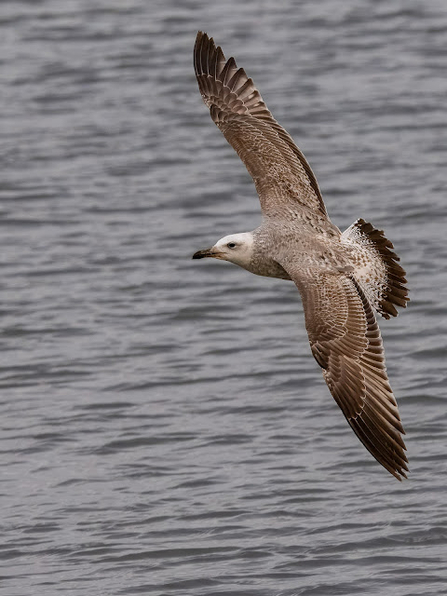
A long-tailed duck dropped onto No 4 for the afternoon
Photo credit: @IvorHewstone
A red kite passing low over the Wetlands
Photo credit: @HarringayBirder

A long-tailed duck dropped onto No 4 for the afternoon
Photo credit: @IvorHewstone
The traditional scramble to maximise the list on New Year's Day saw 64 species recorded, one less than in 2023. But after this lacklustre start, additional species kept coming right to the end of the month to take January total to a very creditable 83 which is nine more than in 2022 and ten more than in 2021.
Our barnacle geese flock arrived back from Cheshunt on the 16th when 16 were counted roosting on No 5. They continued to be seen regularly for the rest of the month. Shelduck numbers built slowly with a maximum count of six. The freezing spell mid-month saw a very high winter count of 115 shoveler on the 18th.
The cold snap encouraged wigeon to visit this January
Photo credit: @MLP
For some inexplicable reason, wigeon - usually a regular winter visitor - gave the Wetlands a miss last January with the first record not until June. There was no such problem this month with two on the 5th, three on the 8th, seven on the 9th, five next day and a single on the 30th. It is also a mystery why red-crested pochard - regular, for example, on the small boating lake in nearby Finsbury Park - is such a rare visitor to the Wetlands. The one-day drake CF found on High Maynard on the 29th was the first since 2021.
The arrival of a drake scaup on No 4 on the 31st again raised hopes the regular wintering bird had returned only for it to disappear again after a two-day stay. Duck, indeed bird, of the month ,however, was the first long-tailed duck since the very unseasonal pair in June 2018. Found by SH on No 4 on the afternoon of the 5th it showed exceptionally well to all those not hampered by work or school but had disappeared by next morning.
The long-tailed duck provided wonderful views pic
Photo credit: @HarringayBirder
Goldeneye numbers remain low. Getting an accurate count was challenging as they moved not only between reservoirs but also - given the changing number of males and females - between different sites in the Lee Valley but numbers never passed five in a day. Goosander are now becoming irregular and often brief visitors from the larger reservoirs to the north. The first was seen flying over on the 6th with records on six other days and a maximum count of two on the 12th and 19th.
A displaying drake goosander on Lockwood
Photo credit: @MLP
The first red kite of the year passed over low on the 6th but otherwise birds of prey were scarce. Peregrines seemed to prefer the pylons on Walthamstow Marsh although they can be found unusually perching on the trees on the sheltered east side of No 1 island when the wind is blowing strongly from the west.
A red kite passing low over the Wetlands
Photo credit: @HarringayBirder
It was an exceptional month for waders with eight species recorded in January, compared to just two last year. They included the long-staying oystercatcher, which was still in residence on the 7th but disappeared as soon as the frost made feeding on the grass verges difficult. The cold snap led to the usual movement of lapwing with 16 on the 9th, two next day, 73 on the 11th including a flock of 47, nine on 18th and two on the 20th. It may also explain why three different dunlin - another bird not recorded at all last winter - were seen on the 11th, 16th and 20th.

Three different dunlin were seen this month
Photo credit: @Elliott1758817
Until very recently, jack snipe was considered a rare bird at the Wetlands but records have become more regular in the last couple of years. This trend has continued with at least two - and probably several more - seen in January. The freezing conditions displaced birds to the reservoirs on the 14th, 16th, 17th, 18th, 19th and 20th with records from the wild flower meadow, No 4, High Maynard, Lockwood and, most regularly, East Warwick. In contrast, common snipe seem if anything scarcer. Although they were seen regularly after the first record on the 7th, there was not the big build-up in numbers often seen in icy conditions in the past.
The wintering common sandpiper was seen throughout the month with two recorded on the 16th. There was also a better than usual showing from green sandpipers with two on the 8th and singles on the 17th, 20th and 21st. A Redshank which landed briefly on Lockwood made it a five wader day on the 17th.
A caspian gull found on High Maynard by SD on the 20th, prompted the traditional blizzard of social media messages. It fortunately hung around - usually on High Maynard - until the 25th to allow the non-larophiles to try to see its ID features for themselves. It seems possible from photographs that there may even have been a second bird on the 23rd.

The caspian gull which launched a thousand messages
Photo credit: @Elliott1758817
While the cold snap encouraged a wide range of ducks and waders to visit, it was disappointing for smaller birds. Only a skylark on the 9th and a siskin next day were at all out-of-the-ordinary. Far from there being a cold weather movement of winter thrushes there were fewer fieldfare than last year with just the odd bird seen although a flock of up to 20 redwing could be seen feeding on the berries by the Engine House throughout the month. At least two stonechats continued to winter around the reed-beds on the Warwicks where the occasional meadow pipit also appeared.